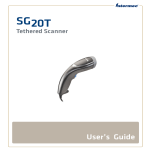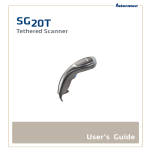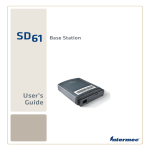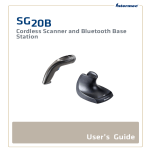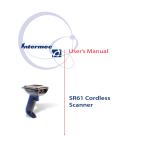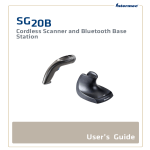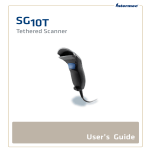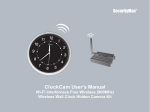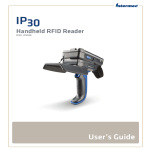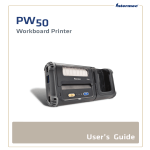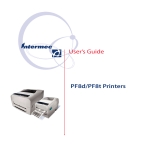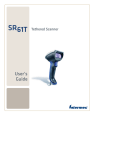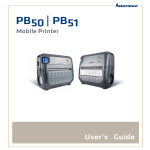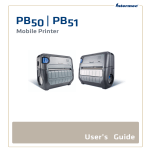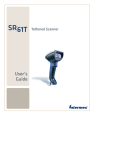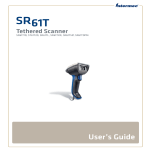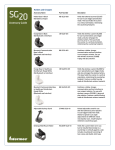Download SG20T Tethered Scanner User's Guide
Transcript
SG20T Tethered Scanner User’s Guide Intermec Technologies Corporation Worldwide Headquarters 6001 36th Ave.W. Everett, WA 98203 U.S.A. www.intermec.com The information contained herein is provided solely for the purpose of allowing customers to operate and service Intermec-manufactured equipment and is not to be released, reproduced, or used for any other purpose without written permission of Intermec Technologies Corporation. Information and specifications contained in this document are subject to change without prior notice and do not represent a commitment on the part of Intermec Technologies Corporation. © 2011by Intermec Technologies Corporation. All rights reserved. The word Intermec, the Intermec logo, Norand, ArciTech, Beverage Routebook, CrossBar, dcBrowser, Duratherm, EasyADC, EasyCoder, EasySet, Fingerprint, i-gistics, INCA (under license), Intellitag, Intellitag Gen2, JANUS, LabelShop, MobileLAN, Picolink, Ready-to-Work, RoutePower, Sabre, ScanPlus, ShopScan, Smart Mobile Computing, SmartSystems, TE 2000, Trakker Antares, and Vista Powered are either trademarks or registered trademarks of Intermec Technologies Corporation. There are U.S. and foreign patents as well as U.S. and foreign patents pending. ii SG20T Tethered Scanner User’s Guide SG20T Tethered Scanner User’s Guide iii iv SG20T Tethered Scanner User’s Guide Contents Contents Before You Begin. . . . . . . . . . . . . . . . . . . . . . . . . . . . . . . . . . . . . . . . . . . . . . . . . . . . . . . . . . . . . . . . viii Safety Information . . . . . . . . . . . . . . . . . . . . . . . . . . . . . . . . . . . . . . . . . . . . . . . . . . . . . . viii Global Services and Support . . . . . . . . . . . . . . . . . . . . . . . . . . . . . . . . . . . . . . . . . . . . . . ix Warranty Information. . . . . . . . . . . . . . . . . . . . . . . . . . . . . . . . . . . . . . . . . . . . ix Web Support . . . . . . . . . . . . . . . . . . . . . . . . . . . . . . . . . . . . . . . . . . . . . . . . . . . . ix Telephone Support . . . . . . . . . . . . . . . . . . . . . . . . . . . . . . . . . . . . . . . . . . . . . . ix Service Location Support . . . . . . . . . . . . . . . . . . . . . . . . . . . . . . . . . . . . . . . . . ix Who Should Read This Manual . . . . . . . . . . . . . . . . . . . . . . . . . . . . . . . . . . . . . . . . . . . . x Related Documents . . . . . . . . . . . . . . . . . . . . . . . . . . . . . . . . . . . . . . . . . . . . . . . . . . . . . . . x Patent Information . . . . . . . . . . . . . . . . . . . . . . . . . . . . . . . . . . . . . . . . . . . . . . . . . . . . . . xi 1 Introducing the SG20T Tethered Scanner ............................. 1 What is the SG20T Tethered Scanner . . . . . . . . . . . . . . . . . . . . . . . . . . . . . . . . . . . . . . . . . . . . . . . 2 Supported Interfaces . . . . . . . . . . . . . . . . . . . . . . . . . . . . . . . . . . . . . . . . . . . . . . . . . . . . . . . . . . . . . . 3 Powering the SG20T . . . . . . . . . . . . . . . . . . . . . . . . . . . . . . . . . . . . . . . . . . . . . . . . . . . . . . . . . . . . . . 3 Connecting the Interface Cable. . . . . . . . . . . . . . . . . . . . . . . . . . . . . . . . . . . . . . . . . . . . . . . . . . . . . 4 Removing the Interface Cable . . . . . . . . . . . . . . . . . . . . . . . . . . . . . . . . . . . . . . . . . . . . . . . . . . . . . . 5 Accessories . . . . . . . . . . . . . . . . . . . . . . . . . . . . . . . . . . . . . . . . . . . . . . . . . . . . . . . . . . . . . . . . . . . . . . . 6 Required Accessories . . . . . . . . . . . . . . . . . . . . . . . . . . . . . . . . . . . . . . . . . . . . . . . . . . . . . . 6 Optional Accessories . . . . . . . . . . . . . . . . . . . . . . . . . . . . . . . . . . . . . . . . . . . . . . . . . . . . . . 6 Desktop / Wall Mount . . . . . . . . . . . . . . . . . . . . . . . . . . . . . . . . . . . . . . . . . . . . 7 Desktop Adjustable Stand . . . . . . . . . . . . . . . . . . . . . . . . . . . . . . . . . . . . . . . . . 7 2 Scanning with the SG20T .............................................. 9 Understanding the Lights. . . . . . . . . . . . . . . . . . . . . . . . . . . . . . . . . . . . . . . . . . . . . . . . . . . . . . . . . 10 Intermec Ready-to-Work Indicator . . . . . . . . . . . . . . . . . . . . . . . . . . . . . . . . . . . . . . . . 10 Status Light . . . . . . . . . . . . . . . . . . . . . . . . . . . . . . . . . . . . . . . . . . . . . . . . . . . . . . . . . . . . . 11 Understanding the Beeps . . . . . . . . . . . . . . . . . . . . . . . . . . . . . . . . . . . . . . . . . . . . . . . . . . . . . . . . . 12 Scanning Bar Codes . . . . . . . . . . . . . . . . . . . . . . . . . . . . . . . . . . . . . . . . . . . . . . . . . . . . . . . . . . . . . . 12 Hands-Free Scanning. . . . . . . . . . . . . . . . . . . . . . . . . . . . . . . . . . . . . . . . . . . . . . . . . . . . . 15 Autostand Triggering Mode . . . . . . . . . . . . . . . . . . . . . . . . . . . . . . . . . . . . . . 15 SG20T Tethered Scanner User’s Guide v Contents 3 SG20T Interfaces . . . . . . . . . . . . . . . . . . . . . . . . . . . . . . . . . . . . . . . . . . . . . . . . . . . . . . . 17 USB Interface. . . . . . . . . . . . . . . . . . . . . . . . . . . . . . . . . . . . . . . . . . . . . . . . . . . . . . . . . . . . . . . . . . . . 18 Connecting a USB Cable. . . . . . . . . . . . . . . . . . . . . . . . . . . . . . . . . . . . . . . . . . . . . . . . . . 18 Setting up the USB Interface . . . . . . . . . . . . . . . . . . . . . . . . . . . . . . . . . . . . . . . . . . . . . . 19 International Keyboard. . . . . . . . . . . . . . . . . . . . . . . . . . . . . . . . . . . . . . . . . . . 19 USB Cable Mode. . . . . . . . . . . . . . . . . . . . . . . . . . . . . . . . . . . . . . . . . . . . . . . . . 21 RS-232 Interface . . . . . . . . . . . . . . . . . . . . . . . . . . . . . . . . . . . . . . . . . . . . . . . . . . . . . . . . . . . . . . . . . 23 Connecting an RS-232 Cable . . . . . . . . . . . . . . . . . . . . . . . . . . . . . . . . . . . . . . . . . . . . . . 23 Setting up the RS-232 Interface . . . . . . . . . . . . . . . . . . . . . . . . . . . . . . . . . . . . . . . . . . . 24 Baud Rate . . . . . . . . . . . . . . . . . . . . . . . . . . . . . . . . . . . . . . . . . . . . . . . . . . . . . . . 24 Data Bits . . . . . . . . . . . . . . . . . . . . . . . . . . . . . . . . . . . . . . . . . . . . . . . . . . . . . . . . 25 Parity . . . . . . . . . . . . . . . . . . . . . . . . . . . . . . . . . . . . . . . . . . . . . . . . . . . . . . . . . . . 25 Stop Bits . . . . . . . . . . . . . . . . . . . . . . . . . . . . . . . . . . . . . . . . . . . . . . . . . . . . . . . . 25 Keyboard Wedge Y-Cable Interface. . . . . . . . . . . . . . . . . . . . . . . . . . . . . . . . . . . . . . . . . . . . . . . . . 26 Connecting a Keyboard Wedge Y-Cable . . . . . . . . . . . . . . . . . . . . . . . . . . . . . . . . . . . . 26 4 Configuring the SG20T Scanner . . . . . . . . . . . . . . . . . . . . . . . . . . . . . . . . . . . . . . 27 Basic Setup with Configuration Bar Codes . . . . . . . . . . . . . . . . . . . . . . . . . . . . . . . . . . . . . . . . . 28 Resetting Your Scanner . . . . . . . . . . . . . . . . . . . . . . . . . . . . . . . . . . . . . . . . . . . . . . . . . . . 28 Configuring the Postamble . . . . . . . . . . . . . . . . . . . . . . . . . . . . . . . . . . . . . . . . . . . . . . . 28 Hands-Free Scanning. . . . . . . . . . . . . . . . . . . . . . . . . . . . . . . . . . . . . . . . . . . . . . . . . . . . . . . . . . . . . 29 Optimizing Decoding . . . . . . . . . . . . . . . . . . . . . . . . . . . . . . . . . . . . . . . . . . . . . . . . . . . . . . . . . . . . 29 Damaged 1-Dimensional Bar Codes . . . . . . . . . . . . . . . . . . . . . . . . . . . . . . . . . . . . . . . 29 Configuring Predefined Imager Modes . . . . . . . . . . . . . . . . . . . . . . . . . . . . . . . . . . . . 30 DPM Mode. . . . . . . . . . . . . . . . . . . . . . . . . . . . . . . . . . . . . . . . . . . . . . . . . . . . . . . . . . . . . . 31 Configuring Your System with EasySet . . . . . . . . . . . . . . . . . . . . . . . . . . . . . . . . . . . . . . . . . . . . 31 Online Setup with EasySet . . . . . . . . . . . . . . . . . . . . . . . . . . . . . . . . . . . . . . . . . . . . . . . . 31 Offline Setup with EasySet . . . . . . . . . . . . . . . . . . . . . . . . . . . . . . . . . . . . . . . . . . . . . . . 32 5 Troubleshooting and Maintaining the SG20T . . . . . . . . . . . . . . . . . . . . . . . 33 Troubleshooting the SG20T . . . . . . . . . . . . . . . . . . . . . . . . . . . . . . . . . . . . . . . . . . . . . . . . . . . . . . 34 Calling Product Support . . . . . . . . . . . . . . . . . . . . . . . . . . . . . . . . . . . . . . . . . . . . . . . . . 34 Problems and Possible Solutions . . . . . . . . . . . . . . . . . . . . . . . . . . . . . . . . . . . . . . . . . . 35 vi SG20T Tethered Scanner User’s Guide Contents Maintaining the SG20T . . . . . . . . . . . . . . . . . . . . . . . . . . . . . . . . . . . . . . . . . . . . . . . . . . . . . . . . . . 37 Upgrading the SG20T . . . . . . . . . . . . . . . . . . . . . . . . . . . . . . . . . . . . . . . . . . . . . . . . . . . . 37 Scanner Recovery . . . . . . . . . . . . . . . . . . . . . . . . . . . . . . . . . . . . . . . . . . . . . . . . . . . . . . . . 42 Cleaning the SG20T. . . . . . . . . . . . . . . . . . . . . . . . . . . . . . . . . . . . . . . . . . . . . . . . . . . . . . 43 A Specifications and Reading Distances . . . . . . . . . . . . . . . . . . . . . . . . . . . . . . 45 Specifications. . . . . . . . . . . . . . . . . . . . . . . . . . . . . . . . . . . . . . . . . . . . . . . . . . . . . . . . . . . . . . . . . . . . 46 Reading Distances . . . . . . . . . . . . . . . . . . . . . . . . . . . . . . . . . . . . . . . . . . . . . . . . . . . . . . . . . . . . . . . 48 SG20T1D . . . . . . . . . . . . . . . . . . . . . . . . . . . . . . . . . . . . . . . . . . . . . . . . . . . . . . . . . . . . . . . 49 SG20THP, SG20THC . . . . . . . . . . . . . . . . . . . . . . . . . . . . . . . . . . . . . . . . . . . . . . . . . . . . 50 SG20T Tethered Scanner User’s Guide vii Contents Before You Begin This section provides you with safety information, technical support information, and sources for additional product information. Safety Information Your safety is extremely important. Read and follow all warnings and cautions in this document before handling and operating Intermec equipment. You can be seriously injured, and equipment and data can be damaged if you do not follow the safety warnings and cautions. This section explains how to identify and understand warnings, cautions, and notes that are in this document. A warning alerts you of an operating procedure, practice, condition, or statement that must be strictly observed to avoid death or serious injury to the persons working on the equipment. A caution alerts you to an operating procedure, practice, condition, or statement that must be strictly observed to prevent equipment damage or destruction, or corruption or loss of data. Note: Notes either provide extra information about a topic or contain special instructions for handling a particular condition or set of circumstances. viii SG20T Tethered Scanner User’s Guide Before You Begin Global Services and Support Warranty Information To understand the warranty for your Intermec product, visit the Intermec web site at www.intermec.com and click Support > Returns and Repairs > Warranty. Disclaimer of warranties: The sample code included in this document is presented for reference only. The code does not necessarily represent complete, tested programs. The code is provided “as is with all faults.” All warranties are expressly disclaimed, including the implied warranties of merchantability and fitness for a particular purpose. Web Support Visit the Intermec web site at www.intermec.com to download our current manuals (in PDF). To order printed versions of the Intermec manuals, contact your local Intermec representative or distributor. Visit the Intermec technical knowledge base (Knowledge Central) at www.intermec.com and click Support > Knowledge Central to review technical information or to request technical support for your Intermec product. Telephone Support In the U.S.A. and Canada, call 1-800-755-5505. Outside the U.S.A. and Canada, contact your local Intermec representative. To search for your local representative, from the Intermec web site, click About Us > Contact Us. Service Location Support For the most current listing of service locations, go to www.intermec.com and click Support >Returns and Repairs > Repair Locations. For technical support in South Korea, use the after service locations listed below: SG20T Tethered Scanner User’s Guide ix Before You Begin AWOO Systems 102-1304 SK Ventium 522 Dangjung-dong Gunpo-si, Gyeonggi-do Korea, South 435-776 Contact: Mr. Sinbum Kang Telephone: +82-31-436-1191 Email: [email protected] IN Information System PTD LTD 6th Floor Daegu Venture Center Bldg 95 Shinchun 3 Dong Donggu, Daegu City, Korea E-mail: [email protected] or [email protected] Who Should Read This Manual This guide is for the person who is responsible for installing, configuring, and maintaining the SG20T. This guide provides you with information about the features of the SG20T, and how to install, configure, operate, maintain, and troubleshoot it. Related Documents The Intermec web site at www.intermec.com contains our documents (as PDF files) that you can download for free. To download documents 1 Visit the Intermec web site at www.intermec.com. 2 Click the Products tab. 3 Using the Products menu, navigate to your product page. For example, to find the CN3 computer product page, click Computers > Handheld Computers > CN3. 4 Click the Manuals tab. If your product does not have its own product page, click Support > Manuals. Use the Product Category field, the Product Family field, and the Product field to help you locate the documentation for your product. x SG20T Tethered Scanner User’s Guide Before You Begin Patent Information Product is covered by one or more of the following patents: 4,882,476; 4,894,523; 4,953,113; 4,970,379; 4,988,852; 5,019,699; 5,021,642; 5,038,024; 5,081,343; 5,095,197; 5,144,119; 5,144,121; 5,182,441; 5,187,355; 5,187,356; 5,216,233; 5,216,550; 5,218,191; 5,233,172; 5,241,488; 5,243,602; 5,258,606; 5,288,985; 5,308,966; 5,342,210; 5,359,185; 5,389,770; 5,397,885; 5,414,251; 5,416,463; 5,442,167; 5,464,972; 5,468,947; 5,468,950; 5,477,044; 5,486,689; 5,500,516; 5,502,297; 5,504,367; 5,514,858; 5,534,684; 5,536,924; 5,539,191; 5,541,419; 5,548,108; 5,550,362; 5,550,364; 5,565,669; 5,572,007; 5,576,529; 5,594,230; 5,598,007; 5,608,578; 5,616,909; 5,619,027; 5,640,001; 5,659,431; 5,672,860; 5,684,290; 5,719,678; 5,729,003; 5,742,041; 5,761,219; 5,764,798; 5,777,308; 5,777,309; 5,777,310; 5,786,583; 5,798,509; 5,798,513; 5,804,805; 5,811,776; 5,811,777; 5,818,027; 5,821,523; 5,834,749; 5,837,987; 5,841,121; 5,842,070; 5,854,478; 5,862,267; 5,869,840; 5,873,070; 5,877,486; 5,878,395; 5,886,338; 5,895,906; 5,902,987; 5,902,988; 5,912,452; 5,923,022; 5,936,224; 5,949,056; 5,969,321; 5,969,326; 5,979,768; 5,987,192; 5,992,750; 6,003,775; 6,012,640; 6,016,960; 6,018,597; 6,024,289; 6,034,379; 6,036,093; 6,039,252; 6,064,763; 6,095,422; 6,097,839; 6,102,289; 6,102,295; 6,119,941; 6,128,414; 6,138,915; 6,149,061; 6,149,063; 6,152,370; 6,155,490; 6,158,661; 6,164,542; 6,164,545; 6,173,893; 6,195,053; 6,234,393; 6,234,395; 6,249,008; 6,328,214; 6,330,975; 6,345,765; 6,356,949; 6,367,699; 6,375,075; 6,375,076; 6,435,411; 6,484,944; 6,641,046; 6,669,087; 6,681,994; 6,688,523; 6,732,930; 6,879,428; 6,889,903; 6,974,085. There may be other U.S. and foreign patents pending. SG20T Tethered Scanner User’s Guide xi Before You Begin xii SG20T Tethered Scanner User’s Guide 1 Introducing the SG20T Tethered Scanner This chapter provides an overview of the SG20T Tethered Scanner. This chapter covers these topics: • What is the SG20T Tethered Scanner • Supported Interfaces • Powering the SG20T • Connecting the Interface Cable • Removing the Interface Cable • Accessories 1 Chapter 1 — Introducing the SG20T Tethered Scanner What is the SG20T Tethered Scanner The SG20T Tethered Scanner is a general purpose handheld scanner. The SG20T is lightweight, ergonomically designed, and it interfaces easily with Intermec computers and other host computers. Scanner window Status light Intermec Ready-to-Work indicator™ Trigger SG20T Tethered Scanner The SG20T is available in the following models: 2 • 1D linear imager—SG20T1D-xxx • High performance 2D area imager—SG20THP-xxx • Health Care 2D area imager—SG20THPHC-xxx SG20T Tethered Scanner User’s Guide Chapter 1 — Introducing the SG20T Tethered Scanner Intermec Technologies Corp. Everett, WA 98203 5V 1.7A , : SG20 IC: ICES-003 CLASS B IC: 1223A-BTM311 ANATEL: 1192-06-0569 Contains TX FCC ID: HN2-BTM311 MEX SCT RCPACBT05-068 MODEL, Made in Singapore ݭɼ૦ծ MFD BDA: XXXXXXXXXXXXXXX , : YY/MM/DD CN: SG20T1D-XXXXXX 12584563214587 Intermec Technologies Corp. Everett, WA 98203 MODEL, , : SG20 5V 1.7A IC: ICES-003 CLASS B Made in Singapore ݭɼ૦ծ MFD , : YY/MM/DD CN: SG20T1D-XXXXXX 12584563214587 SG20T1D-XXXXXX SG20T Scan Engine Option: The scan engine option of your SG20T can be found in the first part of the configuration number. In this illustration, the scan engine option is SG20T1D for 1D linear imager. Supported Interfaces The SG20T supports the following interfaces: • USB—keyboard HID, virtual COM, IBM Sure POS, and HID POS • Standard RS-232 • Keyboard wedge/Y-Cable Powering the SG20T The SG20T is powered through the accessory cable that connects it to the host computer. Depending on your connection, power for the SG20T comes from either the host computer or an external power supply connected to the interface cable. SG20T Tethered Scanner User’s Guide 3 Chapter 1 — Introducing the SG20T Tethered Scanner Connecting the Interface Cable The cable you use depends on the interface and host device. However all cables are connected to the scanner in the same way. To connect the cable, insert it and press firmly until inserted all the way. 4 SG20T Tethered Scanner User’s Guide Chapter 1 — Introducing the SG20T Tethered Scanner Removing the Interface Cable To remove the cable follow these steps: 1 Insert a pin or straightened paper clip into the release hole. 2 Push on the pin or paper clip while pulling out the cable. 1 2 SG20T Tethered Scanner User’s Guide 5 Chapter 1 — Introducing the SG20T Tethered Scanner Accessories There are several different accessories available. Here you will find a list of required and optional accessories. Required Accessories You will need one or more of the following cables for your SG20T. SG20T Cable List Cable Part Number USB cable (6 feet straight) CAB-SG20-USBxxx Keyboard wedge cable (6 feet "Y" straight) CAB-SG20-KBWxxx RS232 Cable, DB9 (6 feet straight) CAB-SG20-SERxxx Universal Intermec power supply 5V 851-089-xxx Note: A power cord is also needed to plug in the power supply. The power cord needed depends on your country and is sold separately. Optional Accessories The following accessories are optional. SG20T Optional Accessories 6 Cable Part Number Desktop / Wall Mount Holder-SG20-xx Desktop Adjustable Stand Stand-SG20-xx SG20T Tethered Scanner User’s Guide Chapter 1 — Introducing the SG20T Tethered Scanner Desktop / Wall Mount The desktop/wall mount holder can be used to store the SG20T when you are not using it. You can attach the holder with screws either to a desk or to a wall. SG20T Desktop / Wall Mount Holder: P/N Holder-SG20-xx Desktop Adjustable Stand The desktop adjustable stand can be used to adjust the scanning angle when using the SG20T as a hands-free scanner (must change the default trigger setting) or to store it when you are not using it. SG20T Desktop Adjustable Stand: P/N Stand-SG20-xx SG20T Tethered Scanner User’s Guide 7 Chapter 1 — Introducing the SG20T Tethered Scanner 8 SG20T Tethered Scanner User’s Guide 2 Scanning with the SG20T This chapter explains how to scan bar codes and includes the following sections: • Understanding the Lights • Understanding the Beeps • Scanning Bar Codes 9 Chapter 2 — Scanning with the SG20T Understanding the Lights The SG20T uses the Intermec Ready-to-Work™ light and Status light to communicate information about your scanner. Intermec Ready-to-Work Indicator The Intermec-Ready-to-Work indicator™ (blue LED) indicates that the scanner is ready to scan bar codes. This light stays on all the time when the scanner is ready to work however your scanner will also flash status information using green and red lights. See the Status Light information in the next section. Blue Intermec Ready-to-Work Indicator Light State What it Means Off Scanner is not ready to scan bar codes. On The SG20T is ready to scan bar codes. Note: By default the Intermec Ready-to-Work light is enabled however you can disable the light if desired. You can also change the color. See EasySet version 5. 6. 5. 1. for more information. 10 SG20T Tethered Scanner User’s Guide Chapter 2 — Scanning with the SG20T Status Light The status light on the SG20T flashes red or green depending on the status of the scanner. Default Status Light Description Light State What it Means Series of green flashes (USB interface only) Power-up At power-up the status light flashes to indicate the activated USB interface: —1 flash = Keyboard HID —3 flashes = Virtual COM —5 flashes = HID POS —6 flashes = IBM POS Hand Held —7 flashes = IBM POS Table Top The status light only flashes at power up for a USB interface. Note: When changing from one USB interface to another the scanner restarts and will also flash the current USB interface. Green light on for 2 seconds The scanner successfully decoded a bar code and sent the data to the host device. Green light flashes 2 A configuration bar code was successfully read. times Red light on for 2 seconds SG20T Tethered Scanner User’s Guide Transmission error OR Configuration bar code was not accepted 11 Chapter 2 — Scanning with the SG20T Understanding the Beeps The SG20T also beeps to give you audio feedback when performing some functions. For example, you hear a beep each time you scan a valid bar code. Default SG20T Beep Descriptions Beep Sequence What it Means Two beeps Power-up Single beep The scanner successfully scanned a bar code. Two fast beeps Configuration bar code successfully scanned Six very fast beeps Transmission error OR Configuration bar code was not accepted Scanning Bar Codes For the SG20THP and SG20THPHC do not look directly into the window area or at a reflection of the laser framing beam while scanning. Long-term exposure to the laser framing beam can damage your vision. The SG20T contains either a 1D linear imager (SG20T1D) or 2D area imager (SG20THP or SG20THC) to scan bar code data. The type of scan engine you are using and the type of bar code you are decoding determines the way you scan the bar code. When you unpack the SG20T, these bar code symbologies are enabled: 12 • Code 39 • Code 128 / GS1-128 • EAN/UPC • PDF417 (SG20THP and SG20THPHC only) • DataMatrix (SG20THP and SG20THPHC only) SG20T Tethered Scanner User’s Guide Chapter 2 — Scanning with the SG20T If you are using bar code labels that are encoded in a different symbology, you need to enable the symbology on your SG20T. Use EasySet version 5.6.5.1 or later to enable and disable symbologies for your scanner. To scan a bar code label with a 1D linear imager 1 Point the SG20T at the bar code label and hold the SG20T at a slight angle 15 to 25 cm (6 to 10 in) from the label. 2 Pull the trigger, and direct the red beam so that it falls across all bars in the bar code label. Use this test bar code: Code 39 Test Bar Code *123456* *123456* Tip: Depending on your screen resolution, you can scan bar codes displayed on your computer screen. By default, when the SG20T successfully reads a bar code label, the SG20T beeps one time, the status light briefly turns green, and the scanner beam turns off. 3 Release the trigger. SG20T Tethered Scanner User’s Guide 13 Chapter 2 — Scanning with the SG20T ABCD ABCD Scanning Bar Codes: The aiming and scanner beams that you see depend on which SG20T model you are using. To scan omni-directionally with the 2D high performance area imager 1 Point the scanner window at the bar code label and hold the SG20T steady a few inches from the label. 2 Pull the trigger and use the laser framing to position the imager over the bar code or area to capture. 30° 20° SG20THP Laser Framing When bar code labels are printed close to each other, try to frame only the bar code you want to read, to avoid reading the wrong bar code. 14 SG20T Tethered Scanner User’s Guide Chapter 2 — Scanning with the SG20T By default, when the SG20T successfully reads a bar code label, the SG20T beeps one time, the status light briefly turns green, and the scanner lighting turns off. 3 Release the trigger. Hands-Free Scanning The SG20T is a handheld scanner however you can scan items without having to hold your scanner in your hand. To do hands-free scanning, you will need to change the triggering mode to Autostand. To activate, see “Hands-Free Scanning” on page 29. Autostand Triggering Mode Autostand mode is different depending on the scanner model. This section explains the difference between: • Autostand for SG20THP/SG20THPHC and • Autostand for SG20T1D Autostand For SG20THP or SG20THPHC Autostand is a mix of Level and Presentation triggering modes. When in Level mode you simply pull the trigger to scan a bar code (hand held scanning). After a period of inactivity the scanner switches to Presentation mode (configurable timeout). In this mode the scanner turns on automatically when it detects movement in front of the scanner window. This allows you to use your scanner for hands-free scanning. To return to Level mode pull the trigger. Autostand For SG20T1D When using the 1D model Autostand is a mix of Level and Flashing triggering modes. When in Level mode you simply pull the trigger to scan a bar code (handheld scanning). After a period of inactivity the scanner switches to Flashing mode (configurable timeout). When the scanner is flashing you can present a bar code in front of the scanner window and it will be scanned. To return to Level mode pull the trigger. SG20T Tethered Scanner User’s Guide 15 Chapter 2 — Scanning with the SG20T 16 SG20T Tethered Scanner User’s Guide 3 SG20T Interfaces This chapter explains the different interfaces available with the SG20T: • USB Interface • RS-232 Interface • Keyboard Wedge Y-Cable Interface 17 Chapter 3 — SG20T Interfaces USB Interface The SG20T can be connected to a USB host using one of the USB cables. The SG20T is USB 2.0 and operates at full speed. Power is provided either by the host or by the external power supply connected to the USB cable. See the “Accessories” on page 6 for a list of part numbers for the different cables. Connecting a USB Cable To connect with a USB cable 1 Connect the USB cable to your SG20T and to the host. Standard USB cable USB cable with power jack 2 Connect the power supply to the cable and an AC power outlet if you are using the externally powered USB cable. 18 SG20T Tethered Scanner User’s Guide Chapter 3 — SG20T Interfaces 3 If your host device is off, turn it on. The scanner beeps twice and the green LED flashes to indicate the USB interface (see “Status Light” on page 11). Note: If you are using a non-powered USB cable, you may get a message that the host does not provide enough power. For example when you connect the USB cable to a keyboard hub or if there are other USB devices connected. In this case use a different hub or disconnect other USB devices. Otherwise use a powered USB cable. 4 If necessary, use the configuration bar codes in the next section to configure your SG20T for an International keyboard. The default keyboard is North America. Setting up the USB Interface This section provides configuration bar codes for a basic USB interface setup. All bar codes marked with (*) indicate the default value. For more configuration options see Chapter 4, "Configuring the SG20T Scanner” on page 27. International Keyboard By default the SG20T uses a North American keyboard layout. Use these configuration bar codes to select the keyboard for your country. Additional keyboards are available in EasySet (see “Configuring Your System with EasySet” on page 31). North American Windows (*) French Windows French Canadian Windows 95/98 SG20T Tethered Scanner User’s Guide 19 Chapter 3 — SG20T Interfaces French Canadian Windows XP/2000 German Windows Spanish Windows Italian Windows Swedish Windows UK English Windows Japanese Windows Brazilian Portuguese Windows Czech Republic Windows Slovakian Windows 20 SG20T Tethered Scanner User’s Guide Chapter 3 — SG20T Interfaces Hungarian 101-Key USB Cable Mode By default the USB cable mode is set to keyboard HID. However you can also set up your scanner to use the following USB cable modes: • HID POS • IBM POS Hand Held • IBM POS Table Top • Virtual COM USB Keyboard HID (*) HID POS IBM POS Hand Held IBM POS Table Top USB Virtual COM Note: When scanning a USB Cable Mode configuration bar code, the scanner beeps twice then restarts. When it restarts it will beep twice and flash a series of green flashes to indicate the USB cable mode (see “Status Light” on page 11). SG20T Tethered Scanner User’s Guide 21 Chapter 3 — SG20T Interfaces USB Virtual COM Driver For a first time setup when using the virtual COM USB cable mode you will need to download and install the driver. You can download the driver from Knowledge Central on the Intermec web site. To download the USB virtual COM driver: 1 Go to http://intermec.custhelp.com. 2 In the search box type “SG20T USB driver” and click Search. 3 Download the driver and instructions. 4 Follow the installation procedure provided in Knowledge Central. After you have installed the driver and set your scanner to USB Virtual COM mode, open the Intermec Virtual Com Port (for example using EasySet or any hyper terminal) before scanning bar codes. 22 SG20T Tethered Scanner User’s Guide Chapter 3 — SG20T Interfaces RS-232 Interface The SG20T can be connected to a host using one of the RS-232 cables. Power is provided by the external power supply connected to the RS232 cable. See the “Required Accessories” on page 6 for a list of part numbers for the different cables. Connecting an RS-232 Cable To connect with an RS-232 cable 1 Turn off your host device. 2 Connect the RS-232 cable to your SG20T and the host. RS-232 cable with power jack 3 Connect the power supply to the cable and an AC power outlet. 4 Turn on the host device. The scanner beeps twice. 5 If necessary, use the configuration bar codes in the next section to configure your SG20T serial parameters to match the PC. SG20T Tethered Scanner User’s Guide 23 Chapter 3 — SG20T Interfaces The default serial parameters for the SG20T are: Serial Parameter Default Setting Baud rate 57600 Data bits 8 Parity None Stop bits 1 Setting up the RS-232 Interface This section provides configuration bar codes for a basic setup. All bar codes marked with (*) indicate the default value. For more configuration options see Chapter 4, "Configuring the SG20T Scanner” on page 27. Baud Rate 38400 57600 (*) 115200 128000 230400 256000 24 SG20T Tethered Scanner User’s Guide Chapter 3 — SG20T Interfaces 460800 Data Bits 7 8 (*) Parity None (*) Even Odd Stop Bits 1 (*) 2 SG20T Tethered Scanner User’s Guide 25 Chapter 3 — SG20T Interfaces Keyboard Wedge Y-Cable Interface The SG20T can be connected to a host using a keyboard wedge Ycable. Power is provided either by the host or by the external power supply connected to the cable. See the “Required Accessories” on page 6 for a list of part numbers for the different cables Connecting a Keyboard Wedge Y-Cable To connect with a keyboard wedge Y-cable 1 Turn off your host device. 2 Connect the Y-cable to your SG20T. Y-cable with optional power supply 3 Connect one end of the Y-cable to your host device and the other end to a PS2 keyboard. If your host device does not provide enough power, connect the power supply to the Y-cable and an AC power outlet. 4 Turn on your host device. The scanner beeps twice. 5 If necessary, configure your SG20T for an International keyboard (see “International Keyboard” on page 19). The default keyboard is North America. 26 SG20T Tethered Scanner User’s Guide 4 Configuring the SG20T Scanner This chapter provides some basic configuration bar codes and information on how to configure the SG20T using the EasySet configuration application. This chapter includes: • Basic Setup with Configuration Bar Codes • Hands-Free Scanning • Optimizing Decoding • Configuring Your System with EasySet 27 Chapter 4 — Configuring the SG20T Scanner Basic Setup with Configuration Bar Codes This chapter provides you with configuration bar codes for a basic setup. For more configuration options, use EasySet (see “Configuring Your System with EasySet” on page 31). Resetting Your Scanner To reset your scanner, read the reset factory defaults configuration bar code. Reset factory defaults Configuring the Postamble The default postamble is <CR> <LF>. For certain applications or when using USB Keyboard HID you may need to change this setting. Use the following configuration bar codes to change the default postamble in your scanner. Carriage Return + Line Feed (*) None Carriage Return Enter 28 SG20T Tethered Scanner User’s Guide Chapter 4 — Configuring the SG20T Scanner Hands-Free Scanning For hands-free scanning as explained in “Hands-Free Scanning” on page 15 activate Autostand triggering mode by scanning this configuration bar code: Autostand Triggering Mode Optimizing Decoding Use the following barcodes to optimize your scanner reading performance. Note: These configuration bar codes are only for the SG20THP and SG20THPHC models. Damaged 1-Dimensional Bar Codes If you are reading 1D bar codes that are damaged or badly printed, enable this setting to enhance the ability to read these types of bar codes. Damaged 1D Codes - Enable Damaged 1D Codes - Disable (*) SG20T Tethered Scanner User’s Guide 29 Chapter 4 — Configuring the SG20T Scanner Configuring Predefined Imager Modes When using a 2D model (SG20THP or SG20THC), you can optimize the reading performance of the scanner by adjusting certain parameters. Since there are many parameters that can be adjusted, we recommend using the pre-defined imager settings to quickly set up your imager for optimized reading. The pre-defined imager settings take in to account the type of bar code, environment and reading surface. There are 4 pre-defined imager settings: • 1-Dimensional bar codes only • Standard 1-dimensional and 2-dimensional bar codes • 1-Dimensional and 2-dimensional bar codes in a bright environment • 1-Dimensional and 2-dimensional bar codes with reflective surface (shiny labels) Select the pre-defined imager setting that best suits your needs: 1D bar codes only Standard 1D and 2D bar codes (*) Standard 1D and 2D bar codes, bright environment Standard 1D and 2D bar codes, reflective surface 30 SG20T Tethered Scanner User’s Guide Chapter 4 — Configuring the SG20T Scanner DPM Mode Direct Product Marking (DPM) is when the bar code is marked directly on the product. Enabling DPM Mode when scanning DPM bar codes optimizes reading this type of code. DPM mode - Enable DPM mode - Disable (*) Note: DPM mode is not required to be able to read DPM bar codes but may be necessary when scanning hard to read DPM bar codes. Configuring Your System with EasySet EasySet is an Intermec configuration application that provides you with two ways to configure your scanner. • Online setup—send configuration commands from EasySet directly to the product. • Offline setup—send configuration commands to a bar code setup sheet, print the setup sheet and use a connected scanner to scan the bar codes. EasySet is available on the Intermec web site at www.intermec.com/ EasySet. Simply download and install. Online Setup with EasySet Online setup with EasySet is only available if you are using an RS-232 cable or a USB cable. To configure your scanner online by sending commands from EasySet 1 Connect the scanner to a host PC using an RS-232 or USB cable and set connection parameters if necessary. SG20T Tethered Scanner User’s Guide 31 Chapter 4 — Configuring the SG20T Scanner 2 Start EasySet. The first time you start EasySet, the Select product dialog box appears. If the Select product dialog box does not appear, choose Product > Select or click on the product icon in the upper left corner. 3 Select your product (SG20T). 4 Select Communication > Select Communication Interface. The Device Selection dialog box appears. 5 Select the communication interface that you are using for your system and click OK. 6 EasySet connects to your scanner and retrieves the current configuration. These configurations are indicated with a blue check mark or blue text. Open the folders to find the configuration commands needed. Double click each command to send it to the scanner. Note: The scanner does not beep when you send configuration commands online from EasySet. Offline Setup with EasySet To configure your scanner offline by scanning bar codes 1 Start EasySet. The first time you start EasySet, the Select product dialog box appears. If the Select product dialog box does not appear, choose Product > Select or click on the product icon in the upper left corner. 2 Select your product. 3 Open the folders to find the configuration commands needed. Double-click each command to send each command to the setup sheet. 4 Click on the print icon to print out the setup sheet and scan the commands. 32 SG20T Tethered Scanner User’s Guide 5 Troubleshooting and Maintaining the SG20T Use this chapter to solve problems you may have while using the SG20T. This chapter contains these topics: • Troubleshooting the SG20T • Maintaining the SG20T 33 Chapter 5 — Troubleshooting and Maintaining the SG20T Troubleshooting the SG20T If you have problems using the SG20T, use this chapter to find a possible solution. Calling Product Support To talk to an Intermec Product Support representative: • In the U.S.A. and Canada, call 1-800-755-5505 • Outside the U.S.A. and Canada, contact your local Intermec representative. For help, go to www.intermec.com > About Us > Contact Us. Before you call Intermec Product Support, make sure you have the following information: • SG20T firmware version • SG20T decode version There are two methods to get the firmware and decode version: • by opening a data collection application and reading the Get firmware version and Get decode version bar codes recommended when using a USB Keyboard HID or keyboard wedge interface, or • by opening EasySet and retrieving the scanner current configuration - recommended when using an RS-232 or USB Virtual Com interface (but also possible with a USB Keyboard HID interface). To get the firmware version and decode version by reading bar codes 1 Run an application that can accept bar code information from the SG20T (for example, Microsoft® Notepad). 2 Scan one of these bar codes: Get firmware version 34 SG20T Tethered Scanner User’s Guide Chapter 5 — Troubleshooting and Maintaining the SG20T Get decode version To get the firmware version and decode version in EasySet 1 Follow the procedure for an online setup with EasySet (see “Online Setup with EasySet” on page 31). 2 When the scanner is connected to EasySet, open the Configuration modes and utilities folder in EasySet. The default firmware and decodes versions appear in blue next to the Get firmware version and Get decode version entries. Problems and Possible Solutions Use this section to find possible solutions to problems you may have. Problems and Possible Solutions Problem Possible Solution You pull the trigger, but The SG20T receives power from either a host or an nothing happens. external power supply through an accessory cable. Make sure: • You are using the appropriate cable. For more information, see “Required Accessories” on page 6. • The cable is connected to the appropriate port on the host computer. • The universal power supply (if necessary) is properly plugged in. SG20T Tethered Scanner User’s Guide 35 Chapter 5 — Troubleshooting and Maintaining the SG20T Problems and Possible Solutions (continued) Problem Possible Solution You pull the trigger, the Try these possible solutions: red scanning beam • Make sure that the SG20T is configured for the turns on, but you symbology you are scanning. cannot successfully scan • Make sure that the SG20T is at the appropriate a bar code. scanning distance from the bar code. Move the SG20T closer and farther away to find the appropriate distance. • Make sure that the SG20T is configured for the type (1D, 2D) of bar code you are scanning. • Make sure the bar code you are trying to scan is not poorly printed or too small. Scan a known good bar code to make sure that the SG20T is working properly. For more information, see “Scanning Bar Codes” on page 12. You scan a bar code and The beep duration, volume, frequency, and number may be configured so that the SG20T the status light turns on, but the SG20T does does not beep. not beep. The SG20T does not recognize or support the You scan a configuration bar code configuration bar code you scanned. and the SG20T beeps six very fast beeps. You scan a bar code, the Try these possible solutions: SG20T beeps once, and • Make sure that your data collection application the status light blinks is set up to receive data from the SG20T. green once, but the data • If you are using an RS-232 cable, make sure that is not transmitted to the the serial parameters on the SG20T match the host computer. serial parameters of the host computer. The default serial parameters for the SG20T are: 57600 baud, 8 data bits, no parity, and 1 stop bit. Print out this bar code and scan it: You cannot scan the Firmware upgrade bar Firmware upgrade code on your computer screen. 36 SG20T Tethered Scanner User’s Guide Chapter 5 — Troubleshooting and Maintaining the SG20T Maintaining the SG20T To keep your SG20T in good working order, you may need to upgrade the SG20T firmware and clean the scanner window. Upgrading the SG20T You may need to upgrade the SG20T firmware if there is an update that incorporates changes to a feature or adds functionality to the scanner. When you upgrade your scanner the current settings are erased and replaced with the default settings. The process of upgrading the SG20T takes about 10 minutes to complete. To upgrade the SG20T you need: • An RS-232 or USB cable. For more information on cables, see “Required Accessories” on page 6. • Minimum PC operating system requirements are Microsoft® Windows® XP with SP2 or Microsoft Windows 2000 with SP4 or higher versions. • EasySet version 5.6.5.1 (see “Configuring Your System with EasySet” on page 31) or later. • The firmware update file (.bin). Note: Before you start the upgrade process, make sure that you are not using the selected COM port for any other application or you receive an error and cannot use the COM port. To upgrade the SG20T firmware 1 Download the latest SG20T firmware update package from the Intermec web site at www.intermec.com. a Go to Support > Downloads. b From the Product Category drop-down list, choose Bar Code Scanners. c From the Product Family drop-down list, choose Tethered. d From the Product drop-down list, choose SG20T Hand Held Scanner and click Submit. SG20T Tethered Scanner User’s Guide 37 Chapter 5 — Troubleshooting and Maintaining the SG20T e Click the link to download the firmware upgrade package and save firmware upgrade file (.bin) to your PC. 2 Connect your SG20T to a host PC with the appropriate cable. . Note: If using a USB cable, you must use the USB Virtual Com USB cable mode. 3 Start EasySet version 5.6.5.1 or later. 4 From the Tools menu, select Upgrade product firmware to start WinFlash. 5 If WinFlash is not already installed you will be asked to install it. Click Yes and follow the installation instructions. After installing Winflash, start WinFlash from the Tools menu, select Upgrade product firmware. 38 SG20T Tethered Scanner User’s Guide Chapter 5 — Troubleshooting and Maintaining the SG20T 6 Select the cable and click Next. SG20T Tethered Scanner User’s Guide 39 Chapter 5 — Troubleshooting and Maintaining the SG20T 7 Use Browse to browse to the location of the firmware upgrade file (.bin), select the file, and click Open. Click Next. 8 For USB cables only, scan the Firmware upgrade bar code that appears on the screen. The scanner disconnects and reconnects (can take up to 4 or 5 seconds). Click OK. For other cables, go directly to the next step. Note: If your scanner cannot scan the bar code on your computer screen see “Problems and Possible Solutions” on page 35 to find the firmware upgrade bar code. Print the page out and scan the bar code. 40 SG20T Tethered Scanner User’s Guide Chapter 5 — Troubleshooting and Maintaining the SG20T 9 Select the Com port and parameters (if necessary) and deselect the Display help check box. Click Next. 10 Click Start download. For RS-232 cables only, scan the Firmware upgrade bar code that appears on the screen and click OK. Note: If your scanner cannot scan the bar code on your computer screen see “Problems and Possible Solutions” on page 35 to find the firmware upgrade bar code. Print the page out and scan the bar code. SG20T Tethered Scanner User’s Guide 41 Chapter 5 — Troubleshooting and Maintaining the SG20T When the firmware download is complete, the “Operation successful” message appears. 11 Click Finish. You have successfully upgraded your scanner firmware. Note: If the firmware download is not successful, you must restart the firmware download procedure. Scanner Recovery If something happens to your scanner and it does not turn on despite using the correct cables and power supply, the only way to recover the scanner is to reinstall the firmware. This is only possible with a download cable. Please contact your Intermec representative. 42 SG20T Tethered Scanner User’s Guide Chapter 5 — Troubleshooting and Maintaining the SG20T Cleaning the SG20T Clean the scanner window as often as needed for the environment in which you are using the SG20T. To clean the scanner window, you can use soapy water, a solution of ammonia and water, or isopropyl alcohol. Opening the SG20T voids the warranty and may cause damage to the internal components. To clean the scanner window 1 Dip a clean towel or rag in soapy water, ammonia and water solution, or isopropyl alcohol and wring out the excess. Wipe the scanner window. Do not allow any abrasive material to touch the window. 2 Wipe dry with a lint-free cloth. SG20T Tethered Scanner User’s Guide 43 Chapter 5 — Troubleshooting and Maintaining the SG20T 44 SG20T Tethered Scanner User’s Guide A Specifications and Reading Distances This appendix contains the technical specifications and reading distances for each scanner model. 45 Appendix A — Specifications and Reading Distances Specifications Use this section to find technical information about the SG20T Physical Dimensions Length 20 cm (7.9 in) Height 6.5 cm (2.6 in) Width 6.1 cm (2.4 in) Weight 125 g (4.4 oz) Electrical Specifications Electrical rating x 5V, 1.7 A Typical Power Consumption—Continuous Scanning (5V power supply, ambient lighting, continuous scanning) SG20T1D RS-232 = 120 mA USB = 120 mA Keyboard wedge = 120 mA SG20THP, SG20THC RS-232 = 300 mA USB = 320 mA Keyboard wedge = 330 mA Typical Power Consumption (5V power supply, ambient lighting, idle after turning on, not scanning) SG20T1D RS-232 = 60 mA USB = 70 mA Keyboard wedge = 120 mA SG20THP, SG20THC RS-232 = 50 mA USB = 70 mA Keyboard wedge = 50 mA 46 SG20T Tethered Scanner User’s Guide Appendix A — Specifications and Reading Distances Interfaces RS-232, USB, Keyboard Wedge Temperature and Environmental Specifications Operating temperature 0°C to 50°C (32°F to 122°F) Storage temperature -20°C to 60°C (-4°F to 140°F) Relative humidity 5 to 95% non-condensing Shock 30 G, 11 ms half-sine, 3 directions Vibrations 8G, from 10Hz to 500Hz, 2hr/axis, 3 axes Environmental rating IP30 Ambient light 0 to 100 000 lux Artificial light 25 000 lux Scanning Performance SG20T1D Scan angle: 38° Minimum X dimension: 6 mils (0.15 mm) SG20THP, SG20THC Scan angles: 34.4° horizontal, 22.2° vertical Framing angles: 30° horizontal, 20° vertical Min. X dimension 1D: 4 mils (0.1 mm) Min. X dimension 2D: 6.6 mils (0.17 mm) Bar Code Symbologies for 2D Models (SG20THP, SG20THC) Australian Post Infomail Aztec Intelligent mail BPO Interleaved 2 of 5 Canada Post Japan Post Codabar Matrix 2 of 5 Codablock A Maxicode SG20T Tethered Scanner User’s Guide 47 Appendix A — Specifications and Reading Distances Bar Code Symbologies for 2D Models (SG20THP, SG20THC) (continued) Codablock F Micro PDF417 Code 11 MSI Code 39 Multicode Code 93/93i PDF417 Code 128 / GS1-128 Planet DataMatrix Plessey Dutch Post Postnet EAN/UPC QR Code GS1 Composite Standard 2 of 5 GS1 DataBar Expanded Sweden Post GS1 DataBar Limited Telepen GS1 DataBar Omni-Directional TLC 39 GS1 DataBar Stacked Bar Code Symbologies for 1D Model (SG20T1D) Codabar GS1 DataBar Limited Code 11 GS1 DataBar Omni-Directional Code 39 Interleaved 2 of 5 Code 93/93i Matrix 2 of 5 Code 128 / GS1-128 MSI EAN/UPC Plessey GS1 Composite (linear only) Standard 2 of 5 GS1 DataBar Expanded Telepen Reading Distances The reading distances for each scanner are typical distances measured from the front end of the scanner bezel in an office environment (200 lux). 48 SG20T Tethered Scanner User’s Guide Appendix A — Specifications and Reading Distances SG20T1D in 0" 2" 4" 6" 8" 10" 12" 14" 16" 18" 20" 10" 25 8" 20 EAN/UPC 6" 15 4" 10 2" 5 0" 0 2" 5 4" 10 0.15 mm/6 mils 6" 15 0.25 mm/10 mils 0.5 mm/20 mils 8" 20 1 mm/40 mils 25 10" 0 5 10 15 20 25 30 35 40 45 50 Symbology Density Minimum Distance Maximum Distance Code 39 0.15 mm (6 mils) 0.25 mm (10 mils) 0.5 mm (20 mils) 1 mm (40 mils) 6 cm (2.36 in) 3 cm (1.18 in) 3 cm (1.18 in) 8 cm (3.15 in) 13 cm (5.12 in) 21 cm (8.26 in) 32 cm (12.6 in) 50 cm (19.68 in) EAN/UPC 0.33 mm (13 mils) 3 cm (1.18 in) 26 cm (10.24 in) SG20T Tethered Scanner User’s Guide cm 49 Appendix A — Specifications and Reading Distances SG20THP, SG20THC 0" 4" 8" 12" 16" 20" 24" 28" 32" in 12" 30 PDF417 15 mils 8" 20 PDF417 10 mils Data Matrix 10 mils 4" 10 0" 0 4" 10 0.125mm/5 mils EAN/UPC 8" 20 0.5 mm / 20 mils 12" 30 1 mm / 40 mils cm 0 10 20 30 40 50 60 70 80 Symbology Density Minimum Distance Maximum Distance Code 39 0.125 mm (5 mils) 0.5 mm (20 mils) 1 mm (40 mils) 4 cm (1.57 in) 5 cm (1.97 in) 12 cm (4.72 in) 12.5 cm (4.92 in) 46 cm (18.11 in) 70 cm (27.56 in) EAN/UPC 0.33 mm (13 mils) 4 cm (1.57 in) 30 cm (11.8 in) PDF417 0.25 mm (10 mils) 0.38 (15 mils) 3 cm (1.18 in) 3 cm (1.18 in) 25 cm (9.84 in) 35 cm (13.78 in) DataMatrix .025 mm (10 mils) 3 cm (1.18 in) 19 cm (7.48 in) 50 SG20T Tethered Scanner User’s Guide Worldwide Headquarters 6001 36th Avenue West Everett, Washington 98203 U.S.A. tel 425.348.2600 fax 425.355.9551 www.intermec.com © 2011 Intermec Technologies Corporation. All rights reserved. SG20T Tethered Scanner User’s Guide DOC-SG20T-UG01 P/N DOC-SG20T-UG01
































































